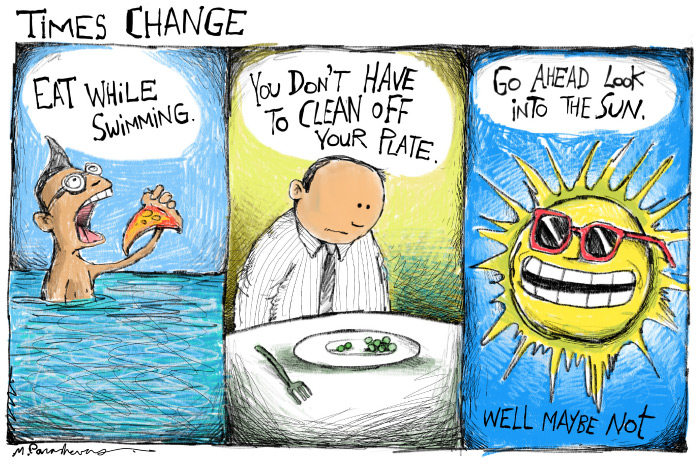Obsolete Medical Advice: No Swimming ’til Half an Hour After Eating & Other Stories

Down at the beach when I was a boy, there was apparently sound medical advice, enforced by our mothers, that said we were not to go swimming for at least a half-hour after eating.
It was a horrible rule, and it was like being sent to jail. We’d sit there on the blanket, tuna fish sandwiches on our breath, and sadly stare at one another wide-eyed while the other kids ran down into the surf to frolic in the sea.
“Is it a half-hour yet?” one of us would ask.
“Another 20 minutes,” a mother would reply.
“Is it a half-hour yet?” we’d ask later.
“I’ll let you know,” the mother would say, after which she would go back to talking to other mothers about a friend of theirs who was pregnant with her seventh or a dangerously impetuous woman they knew who was seeing a new fella who’d already been divorced once.
We’d look at our fathers.
They were reading the newspaper. Dwight Eisenhower had instituted the Marshall Plan to help Europe recover from the war. Raymond Lowe had introduced the Studebaker, a car that looked like a rocket ship.
The fear of going in the water before a half-hour elapsed after eating was getting stomach cramps. The food would be down there in your stomach all in a ball but not going further down yet. Maybe it was from the exertions in the sea, or maybe it was the cold water’s temperature that would set off the dreaded stomach cramps. And that could lead to death by drowning. Mothers had examples to give of mothers they’d heard of whose children had drowned for going in before the half-hour was up.
By the time I had my own little children, the rule had been cut back to a wait of 15 minutes. I don’t know why. It was the hippie era, the 1970s. Surgeon General Koop had required that cigarette packs bear a warning saying it was dangerous to smoke. Perhaps medical research had led to the belief that the requirement for swimming after eating could be cut back to 15 minutes without harm. Or maybe this was just our longhaired rebellion against earlier mothers. A few tried it. Nobody died. Everybody joined in.
The more recent generation, of course, is silent when it comes to the length of time necessary for swimming after eating. After a tuna fish sandwich, a six-year-old will pause briefly to stare at his mother—a sort of leftover primitive memory reflex from the generations before—hear nothing, and then scoot down to the water and run into a wave.
I’ve actually seen people EATING in the ocean. A slice of pizza is handed off while a kid runs in. He holds it high, then bobs around, eating it. Or he has a fanny pack that contains a health bar, and consumes that before the swim back in. (Carefully stowing the wrapper in the pack so as not to further pollute the ocean.) It’s shocking.
Another thing that’s gone by the wayside from my long ago generation is finishing everything on your plate for the starving people in Europe. As I said, Europe was in ruins after the Second World War.
Later, after Europe recovered—it was the Marshall Plan—mothers changed that to “starving people in Asia.” Truth be told, to this day, I consider myself a proud member of the Clean Plate Club, although I still have not got a clue why eating everything on my plate somehow helps the starving people of Europe or Asia. After all, if I eat it, it’s gone, right? Nobody in Europe or Asia can eat it. It remains just one of those things back then that mothers knew the reason for that you had to obey and you have to leave it at that.
Frankly, when perusing Open Table or Dan’s List on my phone, looking for a new place to eat, it is a factor, a positive factor, when a comment says “portions are small.” For me, that’s a plus.



